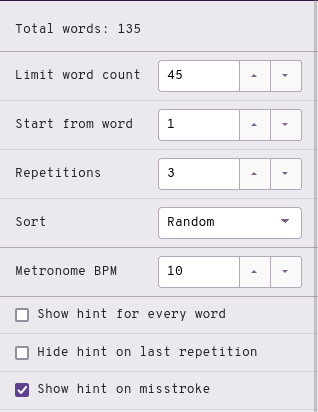Chapter 11: Right hand compound clusters
Useful links
- Right hand -shun, -kshun, and -x words
- Right hand -ment and -let words drill
- Right hand
-BLwords drill - Right hand -shus and -shal words drill
- Chapter 11 test
Intro
All the chords covered so far represent single sounds. However, there are some chords (particularly on the right hand) that can represent multiple syllables. These are referred to as compound clusters.
Right hand -shun, -kshun, and -x
-GSis “-shun” as in “ocean”
-BGSrepresents two sounds:- “-x” as in “tax”
- “-kshun” as in “friction”
Examples
- motion
PHOEGS - caution
KAUGS - fax
TPABGS - tex
TEBGS
-kshun and -x conflicts
Some words like “axe” and “action” conflict with the same outline: ABGS. In these cases, the “-x” sound is given higher priority and “-kshun” sound is relegated to *BGS (same chord, but with the asterisk key).
Examples
- faction
TPA*BGS(sinceTPABGSis already “fax”) - section
S*EBGS(sinceSEBGSis already “sex”)
Mnemonics:
Feel free to come up with your own or even suggest some!
- “mugs in the ocean”
-BGSas the “-x” chord is simply just the combination of the “-k” chord-BGand the-Skey-BGSas the “-kshun” chord overlaps with the “-k” chord-BGand the “-shun” chord-GS
Section practice
Right hand shun, kshun, and x words
Right hand -ment and -let
-PLTis “-ment” as in “moment”
-LTis “-let” as in “scarlet”
Examples
- garment
TKPWARPLT - torment
TORPLT - roulette
RAOULT - wallet
WAULT
Mnemonics:
Feel free to come up with your own or even suggest some!
- Taking the middle out of “ment” gives “mt” which is what
-PLTrepresents - Taking the middle out of “let” gives “lt” which is what
-LTrepresents
Section practice
Right hand -ment and -let words
Unfortunately, there is not a lot of practice material for single stroke words containing these chords.
Right hand -BL and -BLT
-BLrepresents the “-bl” sound as in “global”- When this sound is preceded by a vowel, the
-BLchord can be extended to represent the whole sound as in:- “pliable”
- “possible”
- When this sound is preceded by a vowel, the
-BLTrepresents the “-bility” sound as in “stability”- When this sound is preceded by a vowel, the
-BLTchord can be extended to represent the whole sound as in:- “capability”
- “feasibility”
- When this sound is preceded by a vowel, the
Examples
- rebel
REBL - playable
PHRAEUBL - terrible
TERBL - mobility
PHOEBLT - viability
SRAOEUBLT
Mnemonics:
Feel free to come up with your own or even suggest some!
-BLalready looks a lot like the sounds it represents, it just sometimes skips over an unemphasized vowel.-BLTis just building off of-BLwith a “ity” sound.
Section practice
Right hand -BL and -BLT words drill
Right hand -shus and -shal
-RBSis the “shus” sound as in “cautious”
-RBLis the “shal” sound as in “social”
Examples
- nauseous
TPHAURBS - precious
PRERBS - facial
TPAEURBL - special
SPERBL
Section practice
Right hand -shus and -shal words drill
Unfortunately, there is not a lot of practice material for single stroke words containing these chords.
Chapter 11 test
This chapter’s test consists of all the practice drills in this chapter. Make sure your settings are configured as such:

- Limit word count: 45
- Start from word: 1
- Repetitions: 3
- Sort: random
- Show hint for every word: unchecked
- Hide hint on last repetition: unchecked
- Show hint on misstroke: checked
Click here to access the chapter 11 test
Recommended completion goal
This is only a suggestion if you are unsure of when to move on to the next chapter; it is not a strict requirement!
Aim for 10–20 WPM with 90% accuracy.
You may use the test material as practice!
Chapter briefs
This section is completely optional, but recommended. If you prefer to learn these all at once, they will be covered in chapter 16.
| Translation | Brief | Explanation |
|---|---|---|
| every | EFR | every |
| first | TPEUFRT | Uses an inversion of steno order (-R and -F are swapped) with the -F representing “s” |
| follow | TPOL | follow |
| where | W-R | where |
| could | KUD | |
| would | WUD | |
| should | SHUD | |
| through | THRU | THRAOU is the word “threw” |
NOTE: remember that these are briefs; the explanations are not applicable to any arbitrary word.
Practice sentences
- should you follow them?
- could we first pass through?
- would you know every place?
- where are they?
Answers
SHUD/U/TPOL/THEPL/KW-PLKUD/WAOE/TPEUFRT/PAS/THRU/KW-PLWUD/U/TPHOE/EFR/PHRAEUS/KW-PLW-R/-R/THE/KW-PL
Extra briefs
| Brief | Outline | Explanation |
|---|---|---|
| everyone | EFRPB | EFR + -PB |
| everywhere | WEFRB | EFR + W-R |
| where the | W-RT | W-R + -T |
| through the | THRUT | THRU + -T |